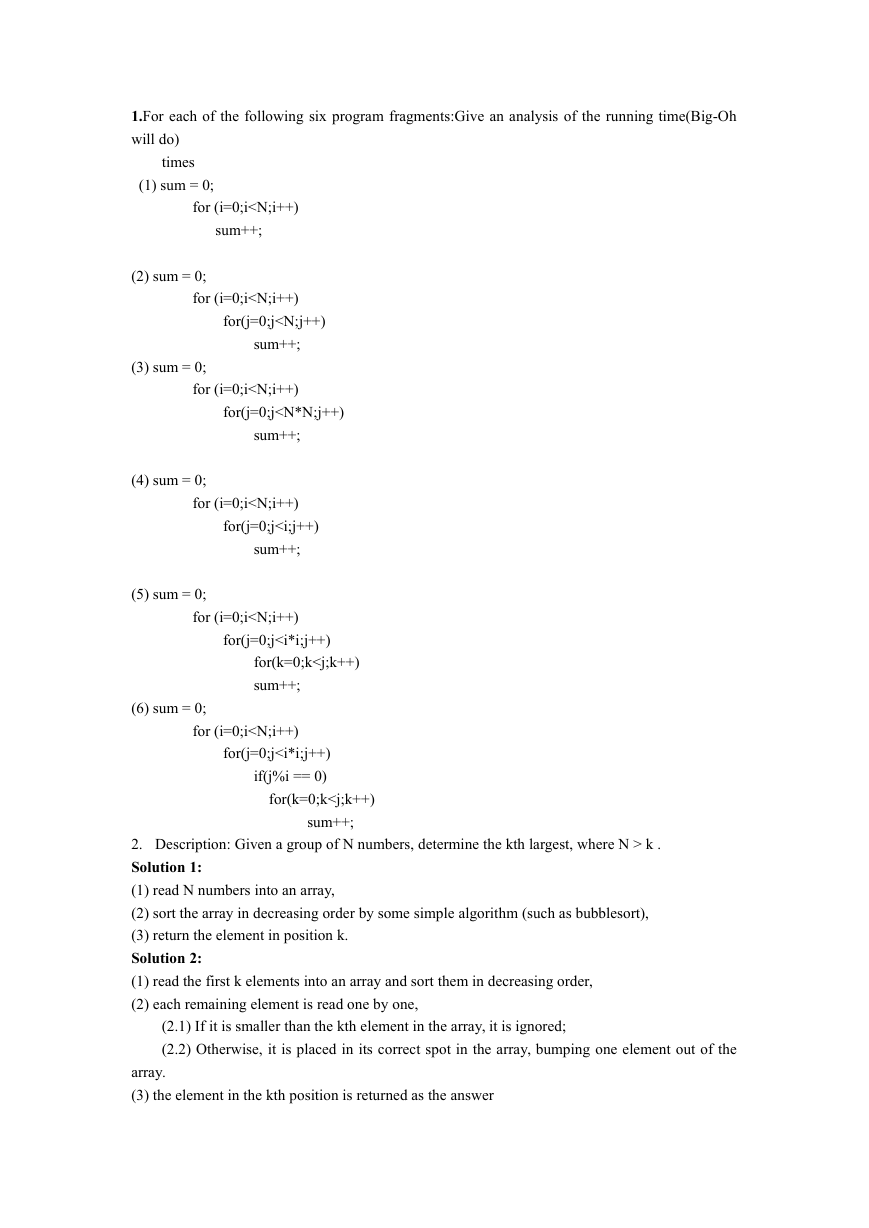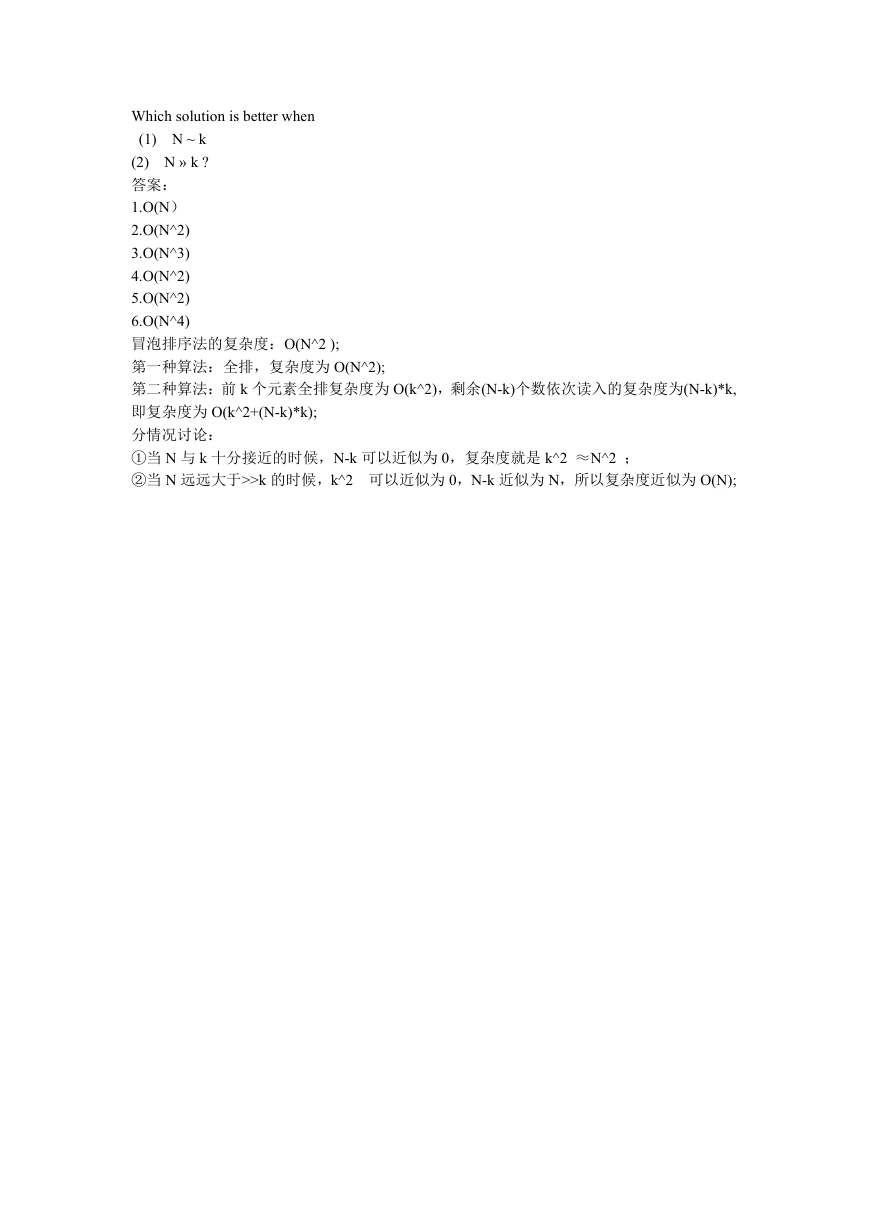1.For each of the following six program fragments:Give an analysis of the running time(Big-Oh
will do)
times
(1) sum = 0;
for (i=0;i k .
Solution 1:
(1) read N numbers into an array,
(2) sort the array in decreasing order by some simple algorithm (such as bubblesort),
(3) return the element in position k.
Solution 2:
(1) read the first k elements into an array and sort them in decreasing order,
(2) each remaining element is read one by one,
(2.1) If it is smaller than the kth element in the array, it is ignored;
(2.2) Otherwise, it is placed in its correct spot in the array, bumping one element out of the
array.
(3) the element in the kth position is returned as the answer
�
Which solution is better when
(1) N ~ k
(2) N » k ?
答案:
1.O(N)
2.O(N^2)
3.O(N^3)
4.O(N^2)
5.O(N^2)
6.O(N^4)
冒泡排序法的复杂度:O(N^2 );
第一种算法:全排,复杂度为 O(N^2);
第二种算法:前 k 个元素全排复杂度为 O(k^2),剩余(N-k)个数依次读入的复杂度为(N-k)*k,
即复杂度为 O(k^2+(N-k)*k);
分情况讨论:
①当 N 与 k 十分接近的时候,N-k 可以近似为 0,复杂度就是 k^2 ≈N^2 ;
②当 N 远远大于>>k 的时候,k^2 可以近似为 0,N-k 近似为 N,所以复杂度近似为 O(N);
�




 2023年江西萍乡中考道德与法治真题及答案.doc
2023年江西萍乡中考道德与法治真题及答案.doc 2012年重庆南川中考生物真题及答案.doc
2012年重庆南川中考生物真题及答案.doc 2013年江西师范大学地理学综合及文艺理论基础考研真题.doc
2013年江西师范大学地理学综合及文艺理论基础考研真题.doc 2020年四川甘孜小升初语文真题及答案I卷.doc
2020年四川甘孜小升初语文真题及答案I卷.doc 2020年注册岩土工程师专业基础考试真题及答案.doc
2020年注册岩土工程师专业基础考试真题及答案.doc 2023-2024学年福建省厦门市九年级上学期数学月考试题及答案.doc
2023-2024学年福建省厦门市九年级上学期数学月考试题及答案.doc 2021-2022学年辽宁省沈阳市大东区九年级上学期语文期末试题及答案.doc
2021-2022学年辽宁省沈阳市大东区九年级上学期语文期末试题及答案.doc 2022-2023学年北京东城区初三第一学期物理期末试卷及答案.doc
2022-2023学年北京东城区初三第一学期物理期末试卷及答案.doc 2018上半年江西教师资格初中地理学科知识与教学能力真题及答案.doc
2018上半年江西教师资格初中地理学科知识与教学能力真题及答案.doc 2012年河北国家公务员申论考试真题及答案-省级.doc
2012年河北国家公务员申论考试真题及答案-省级.doc 2020-2021学年江苏省扬州市江都区邵樊片九年级上学期数学第一次质量检测试题及答案.doc
2020-2021学年江苏省扬州市江都区邵樊片九年级上学期数学第一次质量检测试题及答案.doc 2022下半年黑龙江教师资格证中学综合素质真题及答案.doc
2022下半年黑龙江教师资格证中学综合素质真题及答案.doc